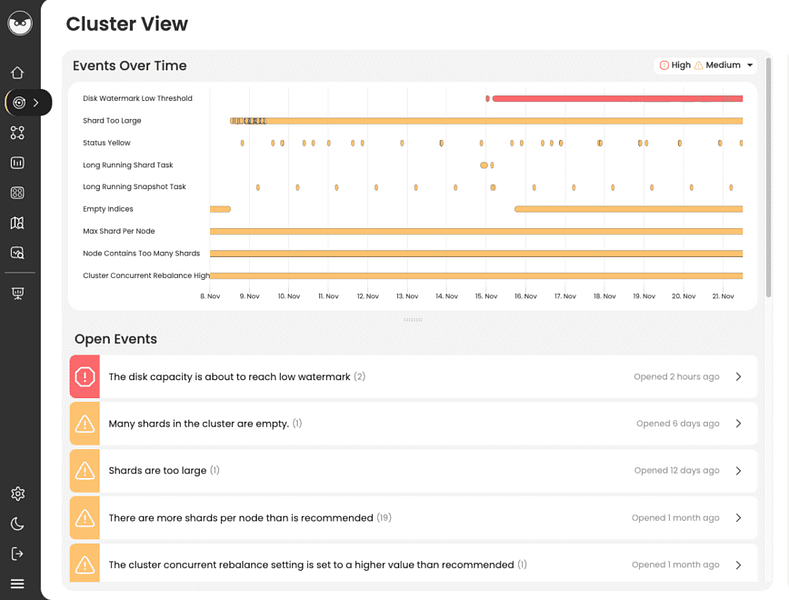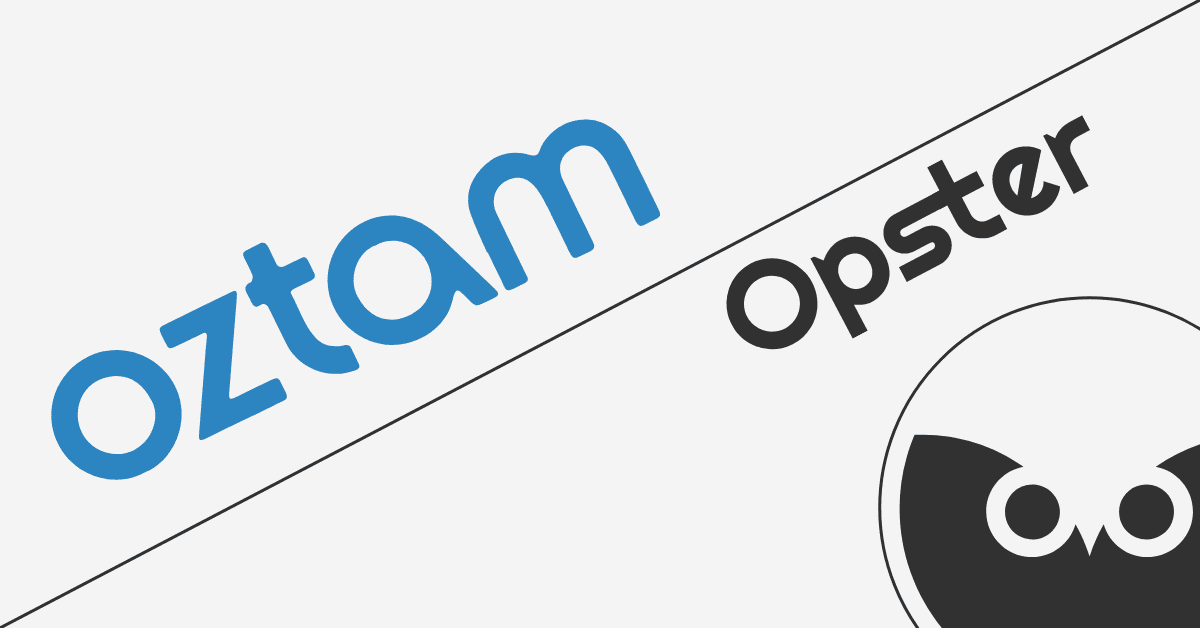Opster Team
Before you begin reading this guide, we recommend you run Elasticsearch Error Check-Up which analyzes 2 JSON files to detect many errors.
Briefly, this error occurs when a node tries to join an Elasticsearch cluster but is not able to do so due to incorrect network settings or other issues. This can lead to data loss or inconsistency, as the node is unable to participate in the cluster’s activities. To resolve this issue, one can try checking the network settings of the affected node, making sure that it is using the correct IP address and port number, or even restarting the node.
To easily locate the root cause and resolve this issue try AutoOps for Elasticsearch & OpenSearch. It diagnoses problems by analyzing hundreds of metrics collected by a lightweight agent and offers guidance for resolving them. Take a self-guided product tour to see for yourself (no registration required).
This guide will help you check for common problems that cause the log ” Node not part of the cluster ; ignoring. ” to appear. To understand the issues related to this log, read the explanation below about the following Elasticsearch concepts: client, cluster and node.
Overview
Any application that interfaces with Elasticsearch to index, update or search data, or to monitor and maintain Elasticsearch using various APIs can be considered a client
It is very important to configure clients properly in order to ensure optimum use of Elasticsearch resources.
Examples
There are many open-source client applications for monitoring, alerting and visualization, such as ElasticHQ, Elastalerts, and Grafana to name a few. On top of Elastic client applications such as filebeat, metricbeat, logstash and kibana that have all been designed to integrate with Elasticsearch.
However it is frequently necessary to create your own client application to interface with Elasticsearch. Below is a simple example of the python client (taken from the client documentation):
from datetime import datetime
from elasticsearch import Elasticsearch
es = Elasticsearch()
doc = {
'author': 'Testing',
'text': 'Elasticsearch: cool. bonsai cool.',
'timestamp': datetime.now(),
}
res = es.index(index="test-index", doc_type='tweet', id=1, body=doc)
print(res['result'])
res = es.get(index="test-index", doc_type='tweet', id=1)
print(res['_source'])
es.indices.refresh(index="test-index")
res = es.search(index="test-index", body={"query": {"match_all": {}}})
print("Got %d Hits:" % res['hits']['total']['value'])
for hit in res['hits']['hits']:
print("%(timestamp)s %(author)s: %(text)s" % hit["_source"])
All of the official Elasticsearch clients follow a similar structure, working as light wrappers around the Elasticsearch rest API, so if you are familiar with Elasticsearch query structure they are usually quite straightforward to implement.
Notes and Good Things to Know
Use official Elasticsearch libraries.
Although it is possible to connect with Elasticsearch using any HTTP method, such as a curl request, the official Elasticsearch libraries have been designed to properly implement connection pooling and keep-alives.
Official Elasticsearch clients are available for java, javascript, Perl, PHP, python, ruby and .NET. Many other programming languages are supported by community versions.
Keep your Elasticsearch version and client versions in sync.
To avoid surprises, always keep your client versions in line with the Elasticsearch version you are using. Always test clients with Elasticsearch since even minor version upgrades can cause issues due to dependencies or a need for code changes.
Load balance across appropriate nodes.
Make sure that the client properly load balances across all of the appropriate nodes in the cluster. In small clusters this will normally mean only across data nodes (never master nodes), or in larger clusters, all dedicated coordinating nodes (if implemented) .
Ensure that the Elasticsearch application properly handles exceptions.
In the case of Elasticsearch being unable to cope with the volume of requests, designing a client application to handle this gracefully (such as through some sort of queueing mechanism) will be better than simply inundating a struggling cluster with repeated requests.
Overview
An Elasticsearch cluster consists of a number of servers (nodes) working together as one. Clustering is a technology which enables Elasticsearch to scale up to hundreds of nodes that together are able to store many terabytes of data and respond coherently to large numbers of requests at the same time.
Search or indexing requests will usually be load-balanced across the Elasticsearch data nodes, and the node that receives the request will relay requests to other nodes as necessary and coordinate the response back to the user.
Notes and good things to know
The key elements to clustering are:
Cluster State – Refers to information about which indices are in the cluster, their data mappings and other information that must be shared between all the nodes to ensure that all operations across the cluster are coherent.
Master Node – Each cluster must elect a single master node responsible for coordinating the cluster and ensuring that each node contains an up-to-date copy of the cluster state.
Cluster Formation – Elasticsearch requires a set of configurations to determine how the cluster is formed, which nodes can join the cluster, and how the nodes collectively elect a master node responsible for controlling the cluster state. These configurations are usually held in the elasticsearch.yml config file, environment variables on the node, or within the cluster state.
Node Roles – In small clusters it is common for all nodes to fill all roles; all nodes can store data, become master nodes or process ingestion pipelines. However as the cluster grows, it is common to allocate specific roles to specific nodes in order to simplify configuration and to make operation more efficient. In particular, it is common to define a limited number of dedicated master nodes.
Replication – Data may be replicated across a number of data nodes. This means that if one node goes down, data is not lost. It also means that a search request can be dealt with by more than one node.
Common problems
Many Elasticsearch problems are caused by operations which place an excessive burden on the cluster because they require an excessive amount of information to be held and transmitted between the nodes as part of the cluster state. For example:
- Shards too small
- Too many fields (field explosion)
Problems may also be caused by inadequate configurations causing situations where the Elasticsearch cluster is unable to safely elect a Master node. This situation is discussed further in:
Backups
Because Elasticsearch is a clustered technology, it is not sufficient to have backups of each node’s data directory. This is because the backups will have been made at different times and so there may not be complete coherency between them. As such, the only way to backup an Elasticsearch cluster is through the use of snapshots, which contain the full picture of an index at any one time.
Cluster resilience
When designing an Elasticsearch cluster, it is important to think about cluster resilience. In particular – what happens when a single node goes down? And for larger clusters where several nodes may share common services such as a network or power supply – what happens if that network or power supply goes down? This is where it is useful to ensure that the master eligible nodes are spread across availability zones, and to use shard allocation awareness to ensure that shards are spread across different racks or availability zones in your data center.
Overview
To put it simply, a node is a single server that is part of a cluster. Each node is assigned one or more roles, which describe the node’s responsibility and operations. Data nodes store the data, and participate in the cluster’s indexing and search capabilities, while master nodes are responsible for managing the cluster’s activities and storing the cluster state, including the metadata.
While it is possible to run several node instances of Elasticsearch on the same hardware, it’s considered a best practice to limit a server to a single running instance of Elasticsearch.
Nodes connect to each other and form a cluster by using a discovery method.
Roles
Master node
Master nodes are in charge of cluster-wide settings and changes – deleting or creating indices and fields, adding or removing nodes and allocating shards to nodes. Each cluster has a single master node that is elected from the master eligible nodes using a distributed consensus algorithm and is reelected if the current master node fails.
Coordinating (client) node
There is some confusion in the use of coordinating node terminology. Client nodes were removed from Elasticsearch after version 2.4 and became coordinating nodes.
Coordinating nodes are nodes that do not hold any configured role. They don’t hold data and are not part of the master eligible group nor execute ingest pipelines. Coordinating nodes serve incoming search requests and act as the query coordinator running query and fetch phases, sending requests to every node that holds a shard being queried. The coordinating node also distributes bulk indexing operations and route queries to shards based on the node’s responsiveness.
Log Context
Log “Node {} not part of the cluster {}; ignoring…” classname is TransportClientNodesService.java.
We extracted the following from Elasticsearch source code for those seeking an in-depth context :
transportService.sendRequest(connection; TransportLivenessAction.NAME; new LivenessRequest();
TransportRequestOptions.builder().withType(TransportRequestOptions.Type.STATE).withTimeout(pingTimeout).build();
handler);
final LivenessResponse livenessResponse = handler.txGet();
if (!ignoreClusterName && !clusterName.equals(livenessResponse.getClusterName())) {
logger.warn("node {} not part of the cluster {}; ignoring..."; listedNode; clusterName);
newFilteredNodes.add(listedNode);
} else {
// use discovered information but do keep the original transport address;
// so people can control which address is exactly used.
DiscoveryNode nodeWithInfo = livenessResponse.getDiscoveryNode();
Find & fix Elasticsearch problems
Opster AutoOps diagnoses & fixes issues in Elasticsearch based on analyzing hundreds of metrics.
Fix Your Cluster IssuesConnect in under 2 minutes

Matt Watson
CTO at Stackify





